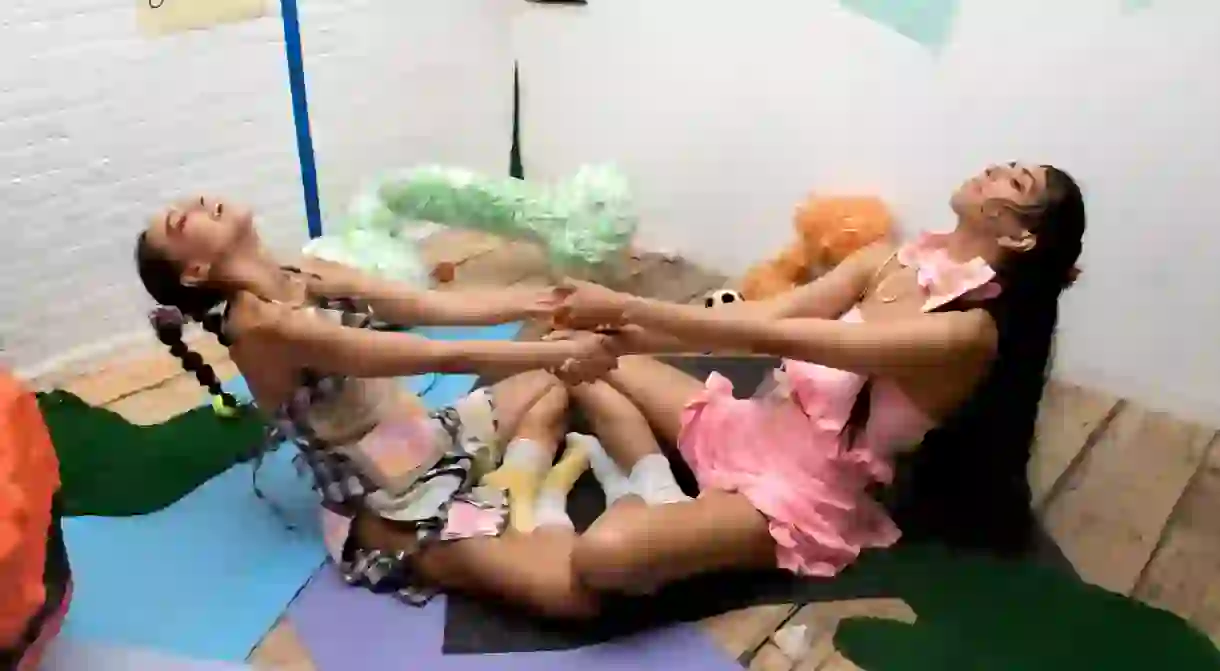How This Designer Is Resisting the Patriarchy With 'Something Happening'

“I have to tell myself all the time that I’m a person. And even when I do, society is always telling me otherwise, or treating me like I’m not,” says Something Happening designer, Cynthia Chang from her Bushwick studio. Chang, who calls herself “cis-passing,” isn’t sure that she identifies as a woman, is a non-binary person. But what does it mean to work in fashion as a non-binary person who’s been socialized as a woman? And on this day, International Women’s Day, where do people like Chang find solidarity?
In 2017, it’s hard being a woman. It’s even harder being a female designer in an industry like fashion, which in many ways is still a “boys club,” according to Man Repeller’s Lauren Sherman. Indeed, if you look at the houses under Kering’s François Pinault and LVMH’s Bernard Arnault (the two big name conglomerates that dominate the fashion world) you will notice, as Sherman points out, that “barely any of the fashion world’s head designers are women.” Why is this happening? Gender discrimination is not unique to the fashion industry, but is the plight of women in the workplace in general. UN Women Deputy Executive Director Lakshmi Puri explains in an op-ed for the UN, penned on March 6, 2017: “Women in all professions face what we call sticky floors, leaking pipelines and broken ladders, glass ceilings and glass walls.” In other words, although many women enter industries like fashion to find careers, they’re just not rising to the top like their male counterparts.

So, imagine, then, what it’s like for a designer like Chang, who sees gender as non-binary. “People read me as a woman,” Chang explains, “and that provides me with a certain amount of safety, but it’s hard to figure out what spaces are mine.”
One space that Chang not only navigates, but owns, is Something Happening, a label the Rhode Island School of Design-trained designer founded three years ago. Trained in sculpture and performance, Chang infuses Something Happening’s designs with artistry, and likes to “activate the clothing through movement.” And, like so many independent designers, Chang creates a community for Something Happening and the clothing that comes out of it. In fact, the label launched primarily as an online shop where Chang sold the work of other artists. Creative consultant Phil Gomez (known to fashion insiders as Styled By Phil) took note of Chang’s work and offered the designer the opportunity to create a collection.

Chang, a proponent of slow fashion, sources materials from thrift store pieces, and then deconstructs them. “My work is very labor intensive,” the designer says. “There’s no way for an indie label to survive, so I started using thrift store pieces and taking them apart—repurposing my finds in innovative ways. I’m totally transparent and democratic about how things are produced. And if someone wants to make clothes, someone can imitate my designs, just as long as it’s not a huge corporation. That’s exploitation.”

Anyone who’s taken a women’s studies class knows the icky and oppressive triangulation of capitalism, patriarchy, and consumption, so by repurposing thrift store finds and designing apparel that’s unisex, Chang challenges “the big three.” “I’ve been living with depression since I was a teen. Living with a chronic illness, the only way to deal is to be silly. I have to tell myself jokes to stay alive.” You’ll find these jokes, as well as slogans hand-embroidered, in Something Happening garments and accessories.

Additionally, the designer uses non-binary models and says, “I know how painful it can be to be read as a woman when you don’t identify as one, so I don’t put my models in anything that shows cleavage when I show [collections on the runway/for presentations].” And although Chang is skeptical of the intentions of brands like H&M and Gucci using transgender model Hari Nef in major campaigns, the designer says seeing Hari Nef out there is “so inspiring. Though I do think some designers are using trans models as tools.”

When it comes to gender, Chang is very frank articulating a sentiment many women can identify with. “I can’t think about my own body without seeing it through a male gaze. Our own opinions about ourselves never feel as important as those provided for us by the patriarchy.”
But perhaps, with more designers like Chang advocating for change, the aforementioned need not keep the status-quo. How’s that for solidarity?













